Eatventure debuted in December 2021, serving as the premiere project of the fledgling Lessmore founded in 2021. Although the company's age barely surpasses that of its hit game, their core team boasts a roster of seasoned professionals. These veterans hail from mobile gaming titans like Kolibri Games, Popcore, LoadComplete, and Rovio. The success of Eatventure wasn't merely serendipitous, it was crafted from deep-rooted expertise in game development.
In this guest post, AppQuantum’s publishing producer, Anastasia Romakha (left), and associate producer, Anastasia Gushchina, discuss what makes Eatventure so popular and how its first successful copycat, Cat Snack Bar, also found its audience in this niche.
Gameplay overview
Eatventure offers a delightful low-poly idle gameplay experience where players delve into the world of restaurant management. Starting from a humble lemonade stand on a city street, players can ascend to managing upscale fine-dining establishments.
Gameplay elements include managing and upgrading food and beverage stations, hiring staff, purchasing perks to enhance production and boost profits, and collecting items. Notably, these items, apart from perks, introduce universal game improvements, affecting profits and staff throughout the game, including during LTE and not just where they're acquired.
Eatventure saw a significant surge in downloads, clocking in nearly 1.5m on Google Play alone.AppQuantum
Eatventure strikes a balance with its gameplay, ensuring it's streamlined yet engaging and free from cluttered mechanics and modes. It possesses a straightforward core loop, a system for collecting items that adds an extra layer to the gameplay, and a rotation of limited-time events that refresh weekly.
By July 2022, Eatventure saw a significant surge in downloads, clocking in nearly 1.5m on Google Play alone. From that point onwards, its revenue has been on an upward trajectory. This success sparked the initial wave of copycats. A subsequent wave emerged in the autumn of 2022 when Eatventure ramped up its scaling efforts. Since January, the market has witnessed a consistent influx of similar titles, with multiple new releases each month.
Let’s look at the data from SensorTower:
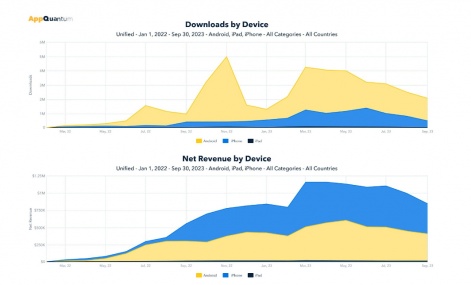
The origin of Cat Snack Bar
Most of Eatventure’s copycats or games that draw inspiration from it are strikingly similar to the original. They often encompass not only the same food-making setting but also identical level designs, sequences, an unchanged set of features, and a core gameplay loop. Given this landscape, where does Cat Snack Bar fit in?
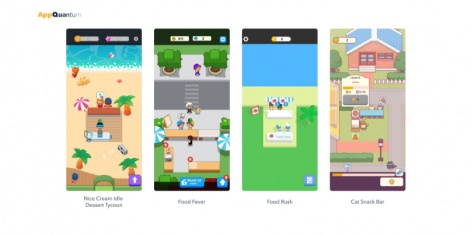
Cat Snack Bar launched nearly a year after Eatventure's debut and just three months after Eatventure's initial scaling - specifically, in late October 2022. Even with this timeline, it was one of the earliest games to draw inspiration from Eatventure and certainly the first copycat that seemed more refined. While the timing of its release undeniably played a role in its success, we believe there's more to the story.
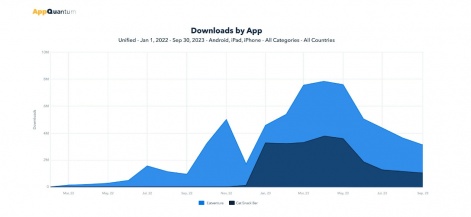
Since its launch Cat Snack Bar has scored over 20m downloads (compared to Eatventure's 40m) and has earned more than $4,000,000 in revenue (excluding ads). Impressively, these figures make it the most successful among all of Eatventure's copycats (we'll also touch upon a few other budding projects later on). But what sets Cat Snack Bar apart?
Cat Snack Bar’s peculiarities
From a first glance at Cat Snack Bar, you can surmise its origins. The game was crafted by the South Korean team Treeplla. Although Treeplla is a newcomer, established in 2021, part of its team formerly worked for Mafgames, a studio with a knack for creating endearing, fluffy cat characters that capture hearts. Within a short span, Treeplla rolled out several titles spanning various art styles in the idle and puzzle genres. However, Cat Snack Bar emerged as their first big success.
What sets Cat Snack Bar apart from the myriad of Eatventure copycats is its distinctive setting and art style. The game immerses players in a cosy, relaxing cat world. While the core loop mirrors that of Eatventure, players interact with and serve adorable, plump kitties in Cat Snack Bar. And the strategy has worked. A demographic analysis of both games reveals that this distinct visual appeal allows Cat Snack Bar to capture a younger, predominantly female audience, thus avoiding direct competition with Eatventure.
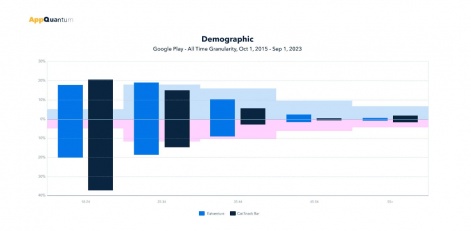
However, it's not merely about adopting a different setting and art direction, even though these factors can significantly propel a game towards success. Treeplla wasn't afraid to innovate. In stark contrast to many Eatventure copycats, Cat Snack Bar provides players with a different gaming experience regarding features and mechanics.
Notably, the game operates at its own rhythm, whereas other projects copy the Eatventure’s balance. Cat Snack Bar is much more lively and dynamic. The developers introduced fresh elements such as eliminating the requisite soft currency needed to advance to subsequent locations, introducing Vault much earlier, and recasting the Invite Helper feature or the Merchant Event with a progressive limited-time offer that combines free and IAP rewards (International Cat Day).
Let's delve deeper into Eatventure's features adopted and refined by Cat Snack Bar to better understand Treeplla’s strategy in enhancing their project.
Item system
How the item system is implemented in Eatventure and Cat Snack Bar differs significantly. On the surface, they might seem similar, but subtle nuances significantly affect the perceived value of items acquired.
In Eatventure, players can use any item for upgrades if they belong to the same category (Hat, Body, or Hand). The game doesn't pressure players to continuously purchase and open chests in search of a specific item.
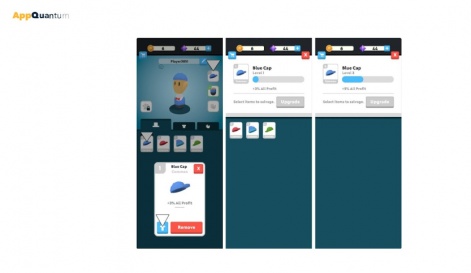
The Eatventure store offers two types of chests, varying in size, with a pair of unique offers available for each of them. It's plausible that the developers deliberately chose this limited set of chests. Such a design simplifies the decision-making process for players when they consider buying chests containing items.
This approach reflects the developers' commitment to minimalism and simplicity in both the upgrading system and the store design, attributes that resonate with casual players, their primary target audience.
In contrast, Cat Snack Bar adopts a more hardcore strategy: upgrades require identical items of the same rarity. This design choice nudges players towards buying more chests in hopes of securing the desired item.
Moreover, this system elevates the perceived offers value, in-game events, and activities that provide specific items. Players can't freely choose and purchase any item in the store. An exception is the Door-to-Door event, which allows players to buy specific items with hard currency at a discounted rate.
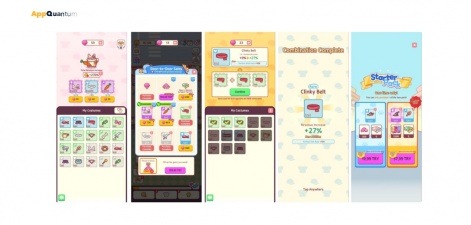
Beyond these offers and events, Cat Snack Bar offers another possibility to obtain items: store chests. The game features three types of chests: a small one, which players can access by watching ads, and medium and large ones, purchasable with hard currency. In this aspect, we observe a minimalist approach reminiscent of Eatventure's design philosophy.
Invite helper
In Eatventure, this feature is introduced once the player unlocks the 3rd slot (Burger) on the 5th level of the first city (San Francisco). This typically occurs around the 4th or 5th day of the player’s lifetime. Every 30 minutes, this feature ostensibly allows players to invite others to assist in serving customers for a 5-minute duration.
Additionally, your avatar can be invited by these "players''. Although it's evident these aren't actual players, the feature encourages you to collect more items. The logic is simple: the more impressive your collection, the higher the likelihood of your avatar being "invited" as a helper during offline periods, granting you some hard currency.
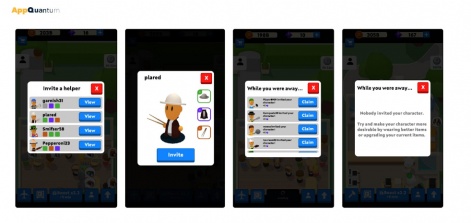
Meanwhile, in Cat Snack Bar, this feature becomes available once players upgrade the 3rd slot (Bagel) on the 4th level (Cafeteria). This milestone is reached much quicker, often on the first day of a lifetime. Unlike Eatventure, Cat Snack Bar doesn’t feign the presence of real players for invites. Instead, the helper resembles an NPC endowed with perks from collected items. There's only one Meownager, eliminating the need to select from a list of potential helpers. A notable difference is that the Meownager remains active even after their five-minute shift has ended. They remain predominantly within the level, awaiting player interaction. Upon tapping the Meownager, players can extend their assistance for another five minutes in exchange for viewing an ad.
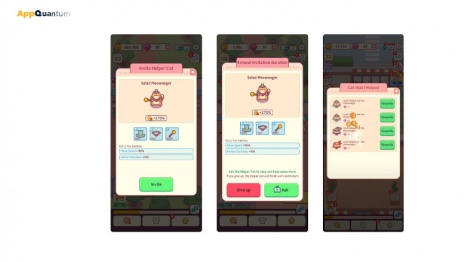
International cat day
Treeplla didn't resort to mere imitation. Among the distinctive features in Eatventure-like projects, the International Cat Day and the various sandwich offers included in the game stand out. Based on the data released by the developers, it's evident that in August 2023, they saw a significant boost in their IAP revenue.
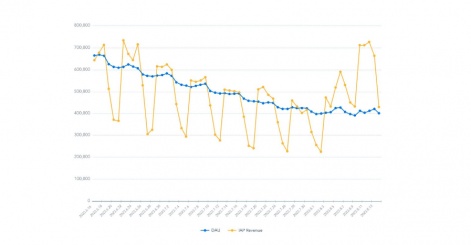
These sandwich offers are intrinsically tied to the core gameplay. This differentiates them from other casual games with similar mechanics, as players can't earn rewards without participating in the core.
To advance within the "sandwich", players must fill the progress bar of the upgrade point and earn special currency. After accumulating enough currency for the upgrade, they can claim the reward, unlock a new level, and continue to fill the progress bar to obtain more special currency.
The rewards for each level alternate between being free and paid. For instance, players cannot access the third level's free reward without first purchasing the second level's paid reward.
While this may seem like an aggressive monetisation tactic on the surface, insights from the developers suggest there hasn't been any cannibalization or diminished interest in making purchases.
Regarding monetisation, Cat Snack Bar boasts significantly more ad placements and IAP options than Eatventure.AppQuantum
Monetisation System
Regarding monetisation, Cat Snack Bar boasts significantly more ad placements and IAP options than Eatventure. The latter even lacks several commonly used and standard placements like speeding up the production for a rewarded ad, Starter Packs, or No-Ads Offer. Eatventure has just a few humble offers, several boosters for hard currency, a couple (literally) of item chests, and hard currency packs - that’s it.
While you might spot two or three new IAP options during one of its weekly limited-time events, this pales compared to Cat Snack Bar. This one offers a double starter pack, full ads remover offer, piggy bank, different packs, chests for ads, progressive limited-time offers, and special hire worker cats. The list goes on.
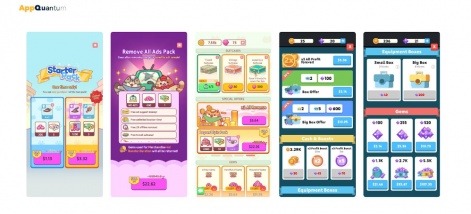
But when examining the Revenue and RPD of both games, does Cat Snack Bar's extensive monetisation strategy truly outshine Eatventure's restrained approach? Although the analytics platform, Sensor Tower, doesn't display ad revenue data, it's evident that Cat Snack Bar not only has more ad placements but also more options for IAP purchases and premium currency expenditure. As a result, we'd expect differences in their IAP RPD if such disparities exist.
From the provided charts (that you may find below), a few amusing facts:
- Firstly, Cat Snack Bar generates less revenue overall than Eatventure, with its RPD in the US being half of Eatventure's.
- Secondly, Cat Snack Bar's revenue distribution sees equal contributions from South Korea and Japan (~30% each) and the US (~30%), whereas Eatventure pulls approximately 55% of its revenue from the US and around 15% combined from Western European countries like Germany and the UK.
- Lastly, the RPD for both projects in South Korea is nearly identical.
Does this imply that Treeplla's monetisation strategies were useless? No, actually. We contend that their efforts were valid given they targeted a distinct audience, which notably differs from Eatventure's (with a heavier focus on the Asian market). If they hadn't devised such an intricate monetisation system, they probably wouldn't be a topic of our discussion.
In closing, it's worth noting that "more" doesn't automatically equate to "better” (although we believe there's significant potential for improvement in Eatventure's monetisation). Developers should always be mindful of their game's unique characteristics. Blindly adopting features from other projects is unwise. Always conduct A/B tests to gauge the impact of any new additions on your audience.
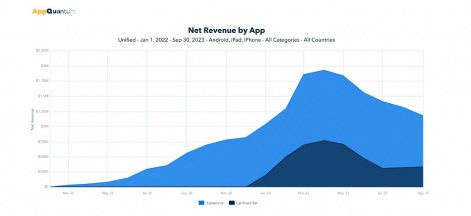
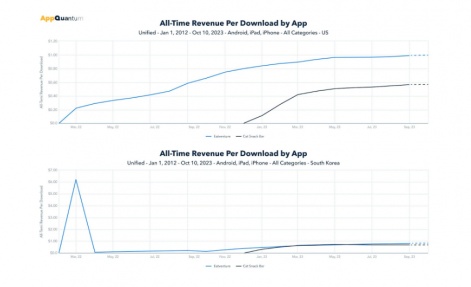

Eatventure — Top 3: US - 54.3%, UK - 7.8%, DE - 7.2%
Cat Snack Bar — Top 3: US - 36.4%, KO - 18.7%, JP - 9.6%
Creative strategies
Eatventure took about a year to transition from its release to scaling and achieving consistent large-scale purchases. In contrast, Cat Snack Bar reached this milestone in a significantly shorter time. One might speculate that Treeplla leveraged a ready-made marketing strategy for its project. But is it really so?
While Cat Snack Bar initially introduced gameplay creatives reminiscent of Eatventure, it is not without its own peculiarities.
Shortly afterwards, Cat Snack Bar transitioned to using non-gameplay creatives that imitated the style of an isometric tycoon game. This is still their popular approach. Meanwhile, Eatventure continues its distinctive approach by using creatives in its UA campaigns that feature altered gameplay closely resembling the actual game.
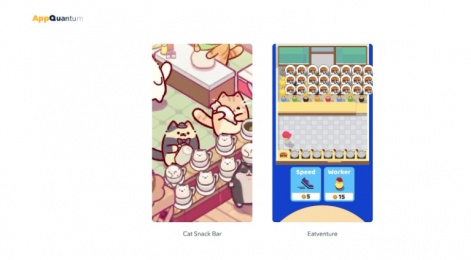
While both games might seem similar product-wise, their marketing strategies are markedly distinct. This observation reinforces our belief that Cat Snack Bar has carved a niche for itself alongside Eatventure. By identifying and catering to a unique audience segment, they've ensured their game resonates with its target demographic.
What about other copycats?
We previously mentioned a surge of new projects similar to Eatventure that began emerging after Eatventure's first scaling in July 2022. Interestingly, Cat Snack Bar also spawned at least two copycats of its own. So, what became of these projects over the last year? In short, none have truly succeeded. However, let's delve a bit deeper.
We identified over 25 games that were unmistakably inspired by Eatventure. These can be grouped into three categories:
- Scam projects aiming to cash in by directly mimicking the original game (e.g., Lemonade Stand and another Eatventure - a complete copy of the original game, including the title).
- Games that merely swapped out the original decor in hopes of becoming a hit (e.g., Nice Cream, My Idle Store).
- Ambitious projects unafraid to experiment with different core mechanics, styles, themes, and perspectives (e.g., Street Cafe, Coffee Venture, Idle Art Tycoon).
The third category is undoubtedly the most fascinating. Not all such projects have shown promise, as seen with Nice City Idle Shop. However, some, like My Hotel Life, might emerge as success stories, potentially attracting copycats of their own. Additionally, there are a few new contenders that we're keenly watching, such as Order Up! and Project Snack Bar.
Indeed, we believe there's space in the market for another game reminiscent of Eatventure - possibly even for several of them.AppQuantum
Is there a place for another Eatventure-like game?
We've finally arrived at the main question. If you've been holding out hope for a silver-bullet solution, you might be disappointed. There isn't one. Our deep dives into Eatventure, Cat Snack Bar, and numerous similar projects have only reaffirmed a truth. There's no singular magic feature that dramatically boosts retention, no special offer that drastically increases conversion to paying users, and no standout ad creative that makes your CPI twice lower than LTV. Success in this industry often stems from years of dedication, countless attempts, failures, and innovations.
Many unsuccessful projects bear similarities, while each successful one carves its unique path to triumph. Cat Snack Bar didn't merely emulate Eatventure. The Treeplla team crafted a game imbued with its own distinct atmosphere, pace, and feature set that harmonises beautifully. Instead of merely treading the path paved by Eatventure, Cat Snack Bar forged its own route.
Indeed, we believe there's space in the market for another game reminiscent of Eatventure - possibly even for several of them. Perhaps the only advice we may give here is not to try to fully copy Eatventure or Cat Snack Bar. While you can use them as foundational inspirations, relying solely on visual and decorative changes won't likely result in a hit game.
For those seeking a more stable and promising trajectory, we suggest identifying a setting that lends itself naturally to introducing fresh gameplay features and modes. Tweaking the core gameplay can pave the way for enhanced monetization and meta gameplay strategies.
Edited by Paige Cook






















